
Taoism or Daoism refers to either a school of philosophical thought or to a religion ; both share ideas and concepts of Chinese origin and emphasize living in harmony with the Tao. The Tao Te Ching, a book containing teachings attributed to Laozi (老子), together with the later writings of Zhuangzi, are both widely considered the keystone works of Taoism.

A Chinatown is an ethnic enclave of Chinese people located outside mainland China, Hong Kong, Macau or Taiwan, most often in an urban setting. Areas known as "Chinatown" exist throughout the world, including Europe, North America, South America, Asia, Africa and Australasia.
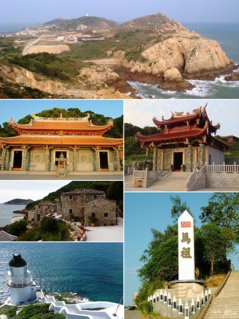
The Matsu Islands, officially Lienchiang County, are an archipelago of 36 islands and islets in the East China Sea governed by the Republic of China (ROC) based in Taiwan, with its location sitting alongside southeastern coast of mainland China. It is the smallest county in Taiwan by area and population, as well as one of two counties that were part of the nominal Fujian Province.
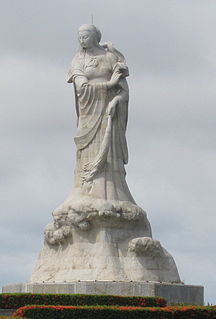
Mazu or Matsu is a Chinese sea goddess also known by several other names and titles. She is the deified form of the legendary figure Lin Mo or Lin Moniang, a Fujianese shamaness whose life span is traditionally dated from 960 to 987. Revered after her death as a tutelary deity of seafarers, including fishermen and sailors, her worship spread throughout China's coastal regions and overseas Chinese communities throughout Southeast Asia and even to the United States, where some Mazuist temples are affiliated with famous Taiwanese temples. She was thought to roam the seas, protecting her believers through miraculous interventions. She is now generally regarded by her believers as a powerful and benevolent Queen of Heaven. Mazu worship is popular in Taiwan as large numbers of early immigrants to Taiwan were Min people; her temple festival is a major event in the country, with the largest celebrations around her temples at Dajia and Beigang.

The People's Republic of China is officially an atheist state, but the government formally recognizes five religions: Buddhism, Taoism, Catholicism, Protestantism, and Islam. In the early 21st century, there has been increasing official recognition of Confucianism and Chinese folk religion as part of China's cultural inheritance. Chinese civilization has historically long been a cradle and host to a variety of the most enduring religio-philosophical traditions of the world. Confucianism and Taoism (Daoism), later joined by Buddhism, constitute the "three teachings" that have shaped Chinese culture. There are no clear boundaries between these intertwined religious systems, which do not claim to be exclusive, and elements of each enrich popular or folk religion. The emperors of China claimed the Mandate of Heaven and participated in Chinese religious practices. In the early 20th century, reform-minded officials and intellectuals attacked all religions as "superstitious"; since 1949, China has been governed by the CCP, a Marxist–Leninist atheist institution that prohibits party members from practicing religion while in office. In the culmination of a series of atheistic and anti-religious campaigns already underway since the late 19th century, the Cultural Revolution against old habits, ideas, customs, and culture, lasting from 1966 to 1976, destroyed or forced them underground. Under subsequent leaders, religious organisations have been given more autonomy.
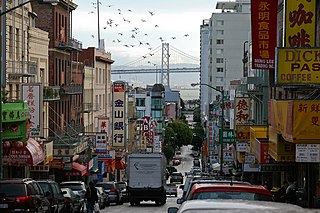
The Chinatown centered on Grant Avenue and Stockton Street in San Francisco, California, is the oldest Chinatown in North America and one of the largest Chinese enclaves outside Asia. It is also the oldest and largest of the four notable Chinese enclaves within San Francisco. Since its establishment in 1848, it has been important and influential in the history and culture of ethnic Chinese immigrants in North America. Chinatown is an enclave that has retained its own customs, languages, places of worship, social clubs, and identity. There are two hospitals, several parks and squares, numerous churches, a post office, and other infrastructure. Recent immigrants, many of whom are elderly, opt to live in Chinatown because of the availability of affordable housing and their familiarity with the culture. San Francisco's Chinatown is also renowned as a major tourist attraction, drawing more visitors annually than the Golden Gate Bridge.

Chinese folk religion, also known as Chinese popular religion is a general term covering a range of traditional religious practices of Han Chinese, including the Chinese diaspora. Vivienne Wee described it as "an empty bowl, which can variously be filled with the contents of institutionalised religions such as Buddhism, Taoism, Confucianism, the Chinese syncretic religions". This includes the veneration of shen (spirits) and ancestors, exorcism of demonic forces, and a belief in the rational order of nature, balance in the universe and reality that can be influenced by human beings and their rulers, as well as spirits and gods. Worship is devoted to gods and immortals, who can be deities of places or natural phenomena, of human behaviour, or founders of family lineages. Stories of these gods are collected into the body of Chinese mythology. By the Song dynasty (960-1279), these practices had been blended with Buddhist doctrines and Taoist teachings to form the popular religious system which has lasted in many ways until the present day. The present day government of mainland China, like the imperial dynasties, tolerates popular religious organizations if they bolster social stability but suppresses or persecutes those that they fear would undermine it.

Matsu Daily (Chinese: 馬祖日報; pinyin: Mǎzǔ Rìbào; Wade–Giles: Ma3-tsu3 Jih4-pao4; Pe̍h-ōe-jī: Má-chó͘-ji̍t-pò) is a newspaper owned by the government of the Lienchiang County, Fujian Province, Republic of China (Taiwan).

Telok Ayer Street is a street located in Singapore's Chinatown within the Outram district, linking Church Street to Cecil Street. Telok Ayer MRT station is located at the junction of Cross Street and this road.

Religion in Taiwan is characterised by a diversity of religious beliefs and practices, predominantly those pertaining to the continued preservation of the ancient Chinese culture and religion. Freedom of religion is inscribed in the constitution of the Republic of China (Taiwan), and ranks high at 9.2 on the Freedom Scale in 2018 according to the World Bank.

Buddhism is one of the major religions of Taiwan. Taiwanese people predominantly practice Mahayana Buddhism, Confucian principles, local practices and Taoist tradition. Roles for religious specialists from both Buddhist and Taoist traditions exist on special occasions such as for childbirth and funerals. Of these, a smaller number identify more specifically with Chinese Buddhist teachings and institutions, without necessarily eschewing practices from other Asian traditions. Around 35% of the population believes in Buddhism.

Chinese temple architecture refer to a type of structures used as place of worship of Chinese Buddhism, Taoism or Chinese folk religion, where people revere ethnic Chinese gods and ancestors. They can be classified as:

The Thien Hau Temple, officially the Ba Thien Hau Pagoda, is a Chinese-style temple of the Chinese Goddess of Sea, Mazu on Nguyễn Trãi Street in the Cho Lon ("Chinatown") of District 5 in Ho Chi Minh City, Vietnam.
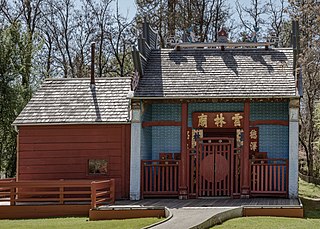
Weaverville Joss House State Historic Park is a state park located in the center of the town of Weaverville, California. The site is a Taoist temple which is still in use, and is the oldest Chinese temple in California.
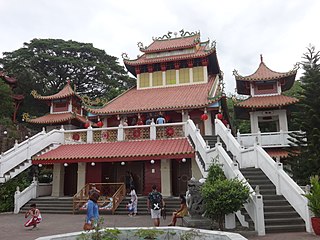
The Ma-Cho, Mazu or Ma Cho Temple is a Taoist temple to the Chinese Sea-Goddess Mazu located on Quezon Avenue in Barangay II, San Fernando, La Union in the Philippines. It was built in 1977 by a group of Filipino-Chinese devotees under the leadership of Dy Keh Hio and with the support of former Tourism Secretary Jose D. Aspiras.

State Temple of the Martial God, also called Tainan Sacrificial Rites Martial Temple or Grand Guandi Temple, is a temple located in Yongfu Rd., West Central District, Tainan, Taiwan. This temple was previously the palace of Koxinga and Prince of Ningjing, members of the Ming royal family who retreated to Taiwan in the dying days of the Ming dynasty.
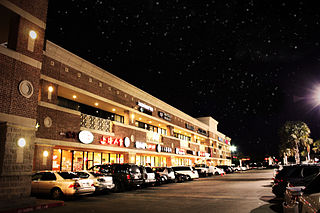
The Houston area population includes a large number of people with Chinese ancestral backgrounds. According to the American Community Survey, as of 2013, Greater Houston has 72,320 residents of Chinese origin.

The Tin How Temple is the oldest extant Taoist temple in San Francisco's Chinatown, and one of the oldest still-operating Chinese temples in the United States. It is dedicated to the Chinese sea goddess Mazu, who is known as Tin How in Cantonese.

The Grand Matsu Temple, also known as the Datianhou or Great Queen of Heaven Temple, is a temple to the Chinese Goddess Mazu, who is the Goddess of Sea and Patron Deity of fishermen, sailors and any occupations related to sea/ocean. The temple is located in the West Central District of Tainan on Taiwan.



















